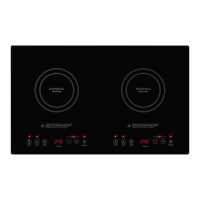10. To disconnect, turn any control to “off,” then remove the plug from the wall
outlet.
11. Do not use the appliance for other than its intended use.
12. Do not attempt to modify or extend the power cord of this appliance.
13. Do not handle the plug with wet hands. This could result in an electric shock.
14. Unplug the power cord by holding the plug, never by pulling the cord.
15. This appliance has a polarized plug (one blade is wider than the other). To
reduce the risk of electric shock, this plug is intended to fit into a polarized
outlet only one way. If the plug does not fit fully into the outlet, reverse the
plug. If it still does not fit, contact a qualified electrician. Do not attempt to
modify the plug in any way.
16. Extreme caution must be used when moving an appliance containing hot oil
or other hot liquids.
17. Household Use Only.
18. Do not cook on a broken cooktop. If the cooktop should break, cleaning
solutions and spills may penetrate the broken cooktop and create a risk of
electric shock.
19. Be careful when you clean the cooktop. If a wet sponge or cloth is used to
wipe spills on a hot cooking surface, be careful to avoid steam burn. Also,
some cleaners can produce noxious fumes if applied to a hot surface.
20. Do not place metallic objects, such as knives, forks, spoons, and lids, on the
cooktop, because they can get hot.
21. User Servicing – Do not repair or replace any part of the appliance unless
specifically recommended in the manual. All other servicing should be
referred to a qualified technician.
22. Use Only Dry Potholders – Moist or damp potholders on hot surfaces may
result in burns from steam. Do not let potholder touch hot heating elements.
Do not use a towel or other bulky cloth.
23. Use Proper Pan Size – This appliance is equipped with one or more surface
units of different size. Select utensils having flat bottoms large enough to
cover the surface unit heating element. The use of undersized utensils will
expose a portion of the heating element to direct contact and may result in
ignition of clothing. Proper relationship of utensil to burner will also improve
efficiency.
24. Utensil Handles Should Be Turned Inward and Not Extend Over Adjacent
Surface Units – To reduce the risk of burns, ignition of flammable materials,
and spillage due to unintentional contact with the utensil, the handle of a
utensil should be positioned so that it is turned inward, and does not extend
over adjacent surface units.
www.insigniaproducts.com
4

